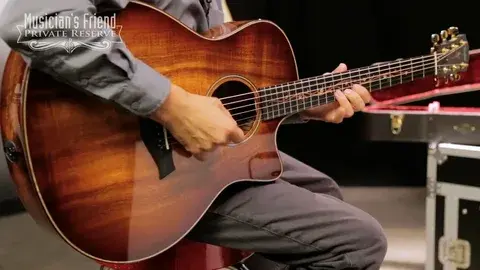If you’ve ever wondered why people go on and on about koa guitars, you’re not alone. What is it about these guitars that makes musicians and collectors alike sing their praises? Are they really worth the investment, or is it just another trend? Let’s talk about it.
When someone says “koa guitar beautiful,” they’re not kidding. There’s a reason koa guitars turn heads – from their stunning looks to their unique sound. If you’re thinking about adding a koa guitar to your collection, or maybe even making it your first, here’s everything you need to know about what makes these guitars such a stand-out.
What Exactly Is Koa Wood?
Let’s start with the basics: koa is a type of wood that grows only in Hawaii. It’s been revered for centuries due to its beauty and durability.
Here’s what you should know about koa:
- Only Found in Hawaii: Koa wood is exclusive to the Hawaiian islands, which makes it rare and highly sought-after. You won’t find this wood naturally growing anywhere else.
- Hardwood with Style: Koa wood is dense and tough, which is why it’s such a fantastic material for instruments.
- Beautiful Grain Patterns: The wood itself is famous for its grain, which has a depth and shine that catches the light in all the right ways. You’ll get swirling lines, waves, and even some flame-like patterns that make each koa guitar beautiful and one-of-a-kind.
Why Musicians Love the Sound of Koa Guitars
Sound matters, right? Koa wood guitars are known for their rich, warm tone, which is especially appealing to folk, blues, and fingerstyle players.
Here’s why the koa guitar sound stands out:
- Starts Bright, Warms Over Time: Brand new koa guitars start with a bright sound, similar to maple wood. But as you play them more, the tone deepens, growing warmer and more resonant. This change makes koa guitars feel like they grow with you.
- Balanced Tone: Koa is known for its balanced midrange, which creates a well-rounded sound that doesn’t overpower on the highs or get too muddy in the lows.
- Responsive to Style: Koa responds beautifully to soft, gentle playing, making it perfect for fingerstyle. But it can also handle a strong strum, giving it versatility that’s hard to beat.
In short, koa guitars offer a sound that’s both complex and adaptable. They’re an instrument that grows with you and reflects your style.
Koa Guitar: Beautiful in Design and Craftsmanship
Now, let’s talk about the look. When people say “koa guitar beautiful,” it’s usually because of the visual experience koa wood offers. Koa guitars aren’t just about the sound; they’re a true work of art.
- Natural Colour Variations: Koa wood typically ranges from a golden brown to a deep red, sometimes even with a hint of purple. These natural colours give koa guitars a warmth and richness that you won’t find in many other woods.
- Eye-Catching Patterns: The wood grain in koa is no joke. With patterns that look like ripples, flames, and waves, no two pieces of koa are alike. This means each guitar is unique – your koa guitar will never look exactly like anyone else’s.
- Aged Beauty: As koa ages, it darkens, making it even more stunning. Over time, your guitar becomes even more special and unique to you.
This wood just gets more beautiful with age, like a fine wine. And for anyone who loves collecting instruments, the aging aspect adds another layer of appeal.
Is a Koa Guitar Worth the Price?
Alright, here’s the part everyone wants to know. Koa guitars aren’t exactly cheap. You’re looking at a decent investment if you’re serious about getting one. So, is it worth it?
- Rarity: Remember, koa is native to Hawaii. Supply is limited, and that naturally drives up the price.
- Durability: Koa wood is as tough as it is beautiful, meaning a koa guitar can stand the test of time. This isn’t a guitar that’ll need replacing after a few years – it’s a lifetime piece.
- Sound Quality Over Time: Koa guitars improve with age. So, unlike other investments that might depreciate, your koa guitar actually gets better and more valuable as you play it.
So, while the upfront cost might make you hesitate, many consider a koa guitar a long-term investment, both for the sound and the beauty.
Tips for Caring for Your Koa Guitar
If you’re about to drop serious money on a koa guitar, you’ll want to know how to take care of it.
Here’s how to keep that koa guitar beautiful for years to come:
- Humidity is Key: Koa wood responds to its environment, so keep your guitar in a stable, humidity-controlled space.
- Clean Gently: Use a soft, dry cloth to clean the surface regularly. Avoid harsh chemicals, as they can strip away the natural oils in the wood.
- Regular Play: Playing your guitar helps bring out that warmer tone over time, so don’t let it sit in the case too long.
Taking proper care of your koa guitar isn’t too complicated, but it’s worth the effort. A well-maintained koa guitar not only sounds better but also maintains its stunning visual appeal.
FAQs About Koa Guitars
Why are koa guitars so expensive?
Koa guitars are pricey due to the limited supply of koa wood and the craftsmanship involved. Koa is exclusive to Hawaii, so that alone adds to its cost.
Do koa guitars sound different from other guitars?
Yes, koa guitars have a unique sound that starts bright and becomes warmer over time. They’re known for a balanced midrange, which makes them perfect for a wide range of styles.
How do I care for my koa guitar?
Keep it in a humidity-controlled environment, clean it gently, and play it regularly to help bring out the warm tones.
Are all koa guitars the same?
Not at all. Each piece of koa wood has unique grain patterns and color variations, so every koa guitar has its own distinct look.
Is a koa guitar beautiful a good investment?
Yes. Not only does the sound improve over time, but koa guitars beautiful also hold their value due to the rarity and beauty of the wood.
The Verdict: Is a Koa Guitar Beautiful and Worth It?
In short, yes. If you’re looking for a guitar that’s as visually stunning as it is sonically versatile, koa is a solid choice. It’s beautiful, durable, and improves with time – what more could you want?
When you play a koa guitar beautiful, you’re not just making music; you’re holding a piece of Hawaii’s natural beauty in your hands. And that’s something special.
Read More: SkinCareSensation

